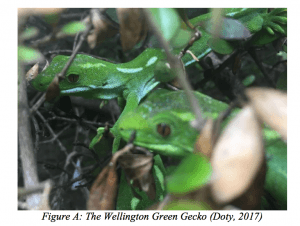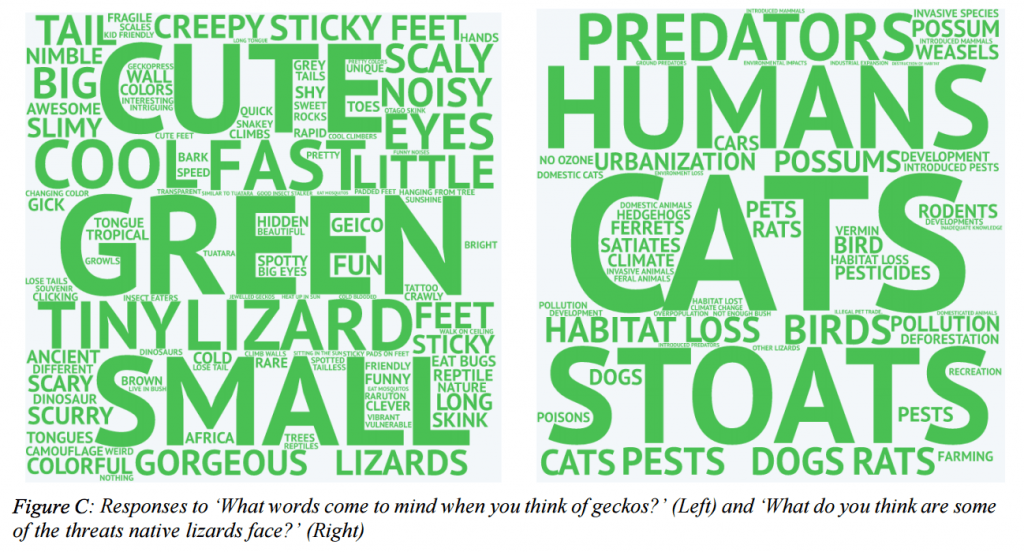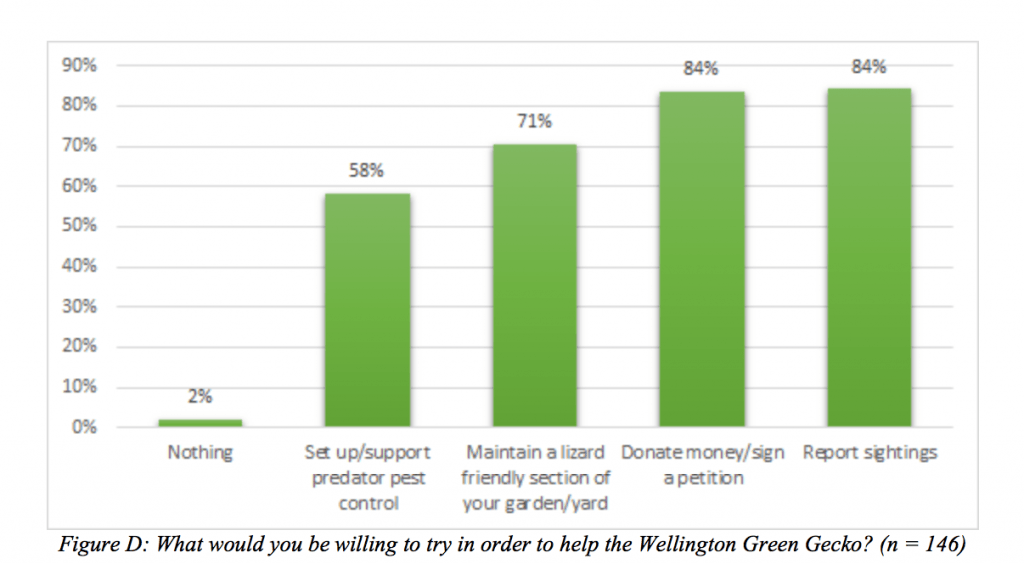Executive Summary
The Wellington Green Gecko (shown in Figure A), Naultinus Elegans Punctatus, is a medium sized lizard that can measure up to approximately 200 mm in length and can be identified by its bright green back, white or yellow spots along its dorsal region and a vivid blue mouth lining (Manaaki Whenua Landcare Research, n.d.). When provoked the gecko displays aggressive behavior and is known to bark, hence its recent renaming as the Barking Gecko (New Zealand Herpetological Society Inc., 2011). As a small lizard, the Wellington Green Gecko is susceptible to predation by and competition with various invasive species such as mice and rats. Habitat loss due to urbanization, agricultural development and wildfires have had an adverse impact on the green gecko population.
General conservation goals for the Wellington Green Gecko have been laid out in the Department of Conservation’s Lizard Action Plan for Poneke Area, Wellington Conservancy 2009-2014 and the Wellington Regional Lizard Network’s (WRLN) Lizard strategy for the Wellington region 2012-20. The Wellington Regional Lizard Network is a group of agencies and organizations that have been working on gecko conservation for several years. The WRLN’s and DOC’s primary goals include educating communities on lizard habitat enhancement in gardens, and recording all lizard sightings on DOC’s Herpetofauna Database (Adams, 2009).
Wellington Zoo has played a major role in conservation efforts in New Zealand. In addition to being the nation’s oldest zoo, Wellington Zoo is the city’s oldest conservation organization, having been established in 1906 (Wellington Zoo, n.d.). A big component in the organization’s work centers on spreading awareness of conservation efforts. In an effort to gauge this awareness level and to educate the public, Wellington Zoo has targeted the Wellington Green Gecko in a public outreach campaign. The zoo aims to eventually extend this campaign to encompass all New Zealand geckos.
Figure B lays out the framework for our project. We surveyed the public to assess public awareness and willingness to engage in conservation efforts. We also reviewed existing programs and interviewed experts to identify gaps in current public-involved conservation plans and innovative approaches for future public outreach projects.
Results and Discussion
Recommendations
Results and Discussion
We obtained 165 general public survey responses from seven different locations throughout the Wellington region and 69 gardener-specific survey responses, not all of which were fully completed. Additionally, we interviewed 10 experts involved in conservation and gecko research.
The results from our survey generally showed that a majority of the public lacks awareness of not only the Wellington Green Gecko specifically but also lizards in general. As we expected, 82% of the respondents to our survey had never heard of the Wellington Green Gecko. Among respondents from Wellington, 20% had heard of the Wellington Green Gecko. Interestingly, 50% of respondents aged 60 or above had heard of the Wellington Green Gecko while 17% of respondents age 45 to 59 and 17% of respondents age 30 to 44 had heard of it. Only 7% of respondents aged 18 to 29 had ever heard of the species.
While many respondents had seen lizards, 72% of respondents said they knew the names of native lizards and 28% did not know the names of any native lizards. Of the participants that claimed to know the names of native lizards, 63% of the respondents named the tuatara which is iv not a lizard. Only one person named the Wellington Green Gecko unprompted. It is good to note that the tuatara might easily be mistaken for a lizard but in fact is listed under the Rhynchocephalia order.
We asked what words came to mind when the respondents thought of geckos, and the answers ranged from cute to creepy. We used the word clouds below to show these responses as well as participant’s perceptions of the risks that lizards face in New Zealand. The most commonly named threats were cats, stoats, and humans. The words are scaled by the frequency with which they appear in responses. The larger the word, the more respondents said it.
Twenty-seven percent of respondents said they would be very interested in helping save New Zealand’s geckos. Thirty-three percent said they were interested, 30% were neutral, 9% were uninterested and 1% said they were not interested at all. We then asked respondents who answered neutral, interested or very interested what they would be willing to do out of the list we provided. Eighty-four percent of respondents said they were willing to report lizard sightings, 84% were willing to donate money or sign a petition, 71% were willing to maintain a lizard friendly section of their garden or yard, 58% were willing to set up or support predator pest control and 2% were not willing to do anything. Figure D below details this distribution.
The gardener survey asked respondents if they would enjoy seeing geckos in their garden. Ninety-eight percent of the respondents replied yes, while 2% replied no. As a follow up to that question, we asked if gardeners would be keen to make their gardens more gecko friendly to which 94% of people responded yes and 6% responded no.
We asked interview subjects to consider one thing that they believe the community should do to save lizards and why they believe it would be effective. In response, multiple experts mentioned pest control or setting up traps to control non-native predator populations. Gecko conservation experts emphasized that close personal exposure to lizards can lead to greater feelings of appreciation and connectedness among members of the public. Without such connections it is likely the public would not notice if gecko populations were thriving and failing. Thus, effective public outreach efforts must strive to make these kinds of personal connections.
We determined that spreading awareness of native geckos and their conservation should take priority over raising public interest to aid in native gecko conservation. Participants seemed to already have a positive valuation of geckos as part of native biodiversity, and many appeared to have some willingness to aid in their conservation. Few respondents described geckos negatively, and the overwhelming majority described them charismatically. The primary issue with gecko conservation appears to be that few members of the general public have detailed knowledge of their biodiversity, their current ecological status, or the conservation efforts aimed at them. Wellington Zoo can therefore aim to target its campaign at spreading awareness of geckos and their conservation, as well as supporting simple, effective means for the public to become involved in gecko conservation.
Recommendations
Through the results of our project we created the following list of recommendations for Wellington Zoo in order to engage the public in gecko conservation. As DOC and WRLN already have a long list of ongoing and planned strategies involving the general public, we focused our recommendations on filling any gaps left by these plans as well as adapting some of these strategies to what the zoo in particular could do. Accordingly, we recommend that the zoo vi continues to work in close collaboration with DOC and WRLN; more specifically we suggest the implementation of the following within the zoo itself:
1. Continue to survey the Wellington region to help obtain stronger, more accurate data, aim to target suburban areas and strive to better understand the Māori perspective of native lizards
2. Devote a section of the Wellington Zoo website to native gecko conservation work
3. Create an informative pamphlet including images and descriptions for each of the Wellington region’s seven species of geckos, along with general information about the conservation status of New Zealand’s geckos
4. Establish a zoo talk time for native lizards
5. Organize a native gecko close encounter program
6. Establish a native lizard exhibit including lizard cages, informative signs, and an example of a lizard friendly garden. Creation of an exhibit would open the opportunity to hold a naming poll for the lizards.
7. Host school programs with the specific aim of connecting and educating children from around the region with native lizard species 8. Increase gecko related merchandise in the Wellington Zoo gift shop
Our research and data collection also pointed to multiple recommendations that could be implemented throughout the entire Wellington region. These efforts could be initiated by Wellington Zoo, but would require the cooperation of the WRLN and other agencies.
1. Advertise a public service announcement about creating lizard friendly sections of their garden and yards
2. Advocate for the design of a mobile application and pocket sized notebook to replace the current ARDS cards
3. Support the development a children’s book and educational television program about New Zealand reptiles, similar to those created by Eyewitness Books 4. Support the filming of a New Zealand lizard documentary





